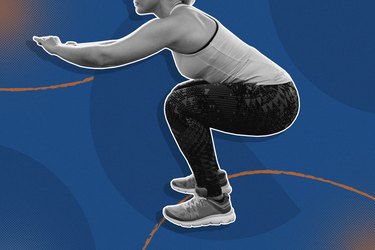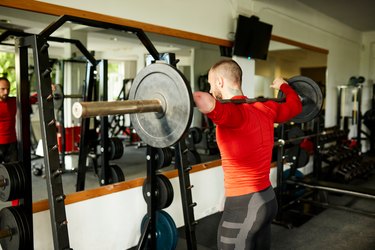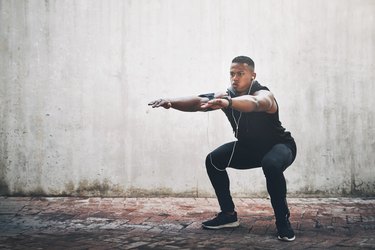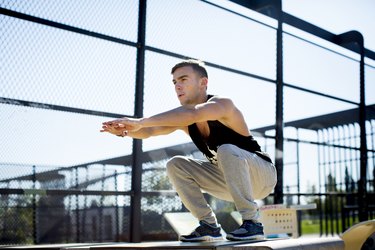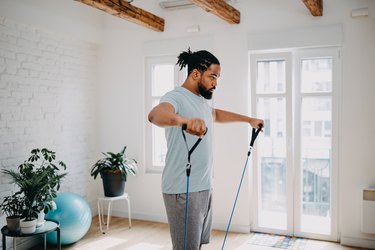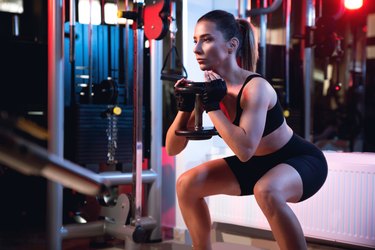
If you're hunting for a beginner-friendly squat variation that works your glutes, quads and hamstrings while being gentle on your back, the goblet squat checks all those boxes — and more.
- What is a goblet squat? A goblet squat is a strength exercise that involves squatting while holding a dumbbell or kettlebell to your chest with both hands.
- Who can do the goblet squat? Just about anyone. The goblet squat is good for beginners and even people with back pain. If you can perform a general squatting motion, you can do a goblet squat.
- What muscles do goblet squats work? The goblet squat strengthens the quadriceps, glutes and hamstrings, says Vanessa Mandell, CPT, ISSA-certified trainer in Los Angeles, California.
- How heavy should you goblet squat? Beginners should start light and keep their movements slow and controlled to work on form, says Mikala Maiers, ACSM-certified clinical exercise physiologist and performance coach with the Future personal training app. Use a weight you can squat for 8 to 12 reps with good form, but that's heavy enough that the last 1 or 2 reps feel challenging. Experiment with lower rep counts and heavier weights once you're confident you've nailed proper goblet squat form.
Video of the Day
Goblet Squat vs. Front Squat
Both a goblet and front squat require holding a weight in front of your body. But a front squat generally involves resting the weight on your shoulders, Maiers says. Goblet squats and front squats work similar muscle groups. However, goblet squats tend to offer more control and stability due to the position of the weight, she says.
How to Do the Goblet Squat With Perfect Form
- Hold a dumbbell or kettlebell against your chest with both hands. If using a dumbbell, place your palms under one end of the weight rather than holding the handle. If using a kettlebell, grip the handles near the base.
- Stand with your feet hip- to shoulder-width apart. Experiment to find the stance that’s most comfortable for you.
- Keeping your chest up and core engaged, sit your hips back and bend your knees to lower into a squat. Your knees should stay above your toes.
- Aim to squat until your thighs are parallel or nearly parallel to the floor.
- Keeping your weight in your heels, straighten your knees and drive through your hips to return to the starting position.
- Repeat for your desired number of reps.
Tip
Soft, cushioned running shoes aren’t the ideal footwear for performing a goblet squat. Mark Bohannon, CPT, personal trainer and senior vice president of North American operations at personal training company Ultimate Performance, recommends finding a hard-soled, flat shoe. “[That] will give you a more stable base,” he says.
3 Goblet Squat Benefits
Any type of squat will challenge your lower body and help you build strength and power. But there are a few unique perks of the goblet squat to know about.
1. It's Good for Beginners
The goblet squat is similar to a front squat in that both require holding a weight in front of you. However, the goblet squat is typically a little easier to learn, especially compared to the barbell front squat.
"Performing a front squat with a barbell is a more difficult, challenging move to do right, and is a significant progression from a goblet squat," Bohannon says. The barbell front squat requires you to brace your core while lifting your elbows and bending your wrists back to support the bar with your fingertips, he notes. This calls for significant control, skill and strength (not to mention plenty of shoulder and wrist mobility).
The goblet squat is less technical but allows you to work many of the same muscles as a barbell front squat.
"It's a perfect move for someone who's relatively inexperienced in the gym and wants to build up their strength before progressing to more difficult moves," Bohannon says.
2. It Works More of Your Core
Like other squat variations, the goblet squat targets the quads, glutes and hamstrings. "However, with the goblet squat, you'll be getting more core engagement from holding the weight in front of your body," Maiers says.
In particular, you'll work the abdominal muscles, including the rectus abdominis (the "six-pack" muscle), the obliques (the ab muscles on your sides) and the transverse abdominis (the deepest ab muscle).
3. It's Easier on Your Back
Maintaining an upright torso during a squat will lower your risk of back pain from squatting. Many people feel lower back pain from squats from hyperextending (overarching) their spine to maintain their center of gravity, "putting more pressure on the lower back," Bohannon says.
The goblet squat puts the weight in front of your body, which acts as a counterbalance. This makes it easier to maintain an upright torso during the goblet squat, especially compared to the barbell back squat, which places the weight behind your body. That means the goblet squat may be gentler on your back than other squat variations.
4 Common Goblet Squat Mistakes and How to Fix Them
Even though goblet squats can be easier to learn than some other variations, there are still some common form mistakes trainers say to avoid.
1. Losing Balance in the Bottom Position
Some people can't keep their heels on the ground when they squat down without losing their balance. This can happen if your hip and ankle joints aren't mobile enough to flex to the extent required to bring your pelvis, thighs, shins and feet closer together.
So, if you can't keep your heels on the ground when you squat without losing your balance, Mandell says you may need to work on your hip and ankle mobility.
Fix It: Hold the bottom position of the goblet squat to get your hips and ankles more flexible in this position. "You can move the weight farther in front of your chest to better balance if you feel like you're falling backward," Mandell says.
Hold this bottom position for 20 seconds. Rest for 30 seconds and repeat twice (for 3 rounds total). Mandell suggests incorporating this into your warmup for goblet squats.
If that's too advanced, sit in a deep squat position while holding onto a pole or bench to keep yourself from falling. "Make sure your heels stay on the ground while your back is upright," Mandell says.
A sumo squat stance versus a regular squat stance may also be helpful, but that will work slightly different muscles in the legs, placing more emphasis on the inner thigh adductors.
2. Rounding Your Upper Back
When you hold a heavy weight in front of your chest, there's a risk that your upper back will round in response to the tension. Poor posture caused by weakness in the upper back muscles can also cause rounding.
Squatting with a rounded upper back puts extra pressure on your neck and spine, which increases your risk of pain and injury, Bohannon says.
Fix It: Focus on drawing your shoulder blades back and down and keeping your upper chest lifted during the goblet squat, Bohannon says.
3. Letting Your Knees Cave In
Another common goblet squat mistake is letting your knees cave in, Maiers says. When your knees dip inward, they take on added strain — especially on the inner part of the joint. Over time, the extra strain may lead to knee pain or injury, Maiers says.
Fix It: If you experience soreness or discomfort in the inner part of your knees during or after goblet squats, imagine you're wearing a mini resistance band around your thighs "and you're pushing out against it at all times [during the squat]," Maiers suggests. Or, you can actually wear a mini band: Loop it around your legs above your knees and push against it while you squat.
4. Arching Your Lower Back
Arching your lower back during goblet squats is a common mistake that can lead to or aggravate lower back pain, Maiers says.
You may arch your lower back if your posture is poor, your back muscles are weak or the load is too heavy for you to manage. If you don't address the arch, you may develop back pain or injury thanks to the added pressure on your spine, Bohannon says.
Fix It: If you feel lower back discomfort or pain during or after goblet squats, try tilting your pelvis slightly under. "Think of your pelvis as a tortilla chip: Scoop the chip before initiating the squat," Maiers says.
3 Goblet Squat Variations
Once you get comfortable with a standard goblet squat, you can spice up your squat routine with these variations.
1. Heels-Elevated Goblet Squat
"This is my personal favorite goblet squat variation," Mandell says. Elevating your heels on a rolled-up mat or weight plate enables you to target the quads more effectively and sink deeper into the squat without sacrificing form. "A bigger range of motion is often a good thing, and in this case, recruits more muscles," Mandell says.
- Hold a kettlebell or dumbbell in the goblet squat position. Stand with your feet hip- to shoulder-width apart and your heels slightly elevated on a rolled-up mat or weight plate.
- Bend your knees to lower into a squat. Your knees should stay above your toes.
- Pause briefly, then push through both feet to return to standing.
- Repeat for your desired number of reps.
Tip
You may feel the tendency to lean forward as you sink into the squat — especially if your heels are significantly elevated. Start with smaller elevations (e.g., a folded mat) and work your way up (e.g., a weight plate).
2. Explosive Goblet Squat
This exercise is an advanced variation of a traditional goblet squat. Slowing the lowering phase of the squat forces your muscles to brace against the weight for a longer period. Meanwhile, exploding upward from the bottom position of the squat requires more power than simply standing up. "This will tire you out faster than you might think and takes the exercise to a new level," Mandell says.
- Hold a kettlebell or dumbbell in the goblet squat position and stand with your feet hip- to shoulder-width apart.
- Bend your knees to slowly lower into a squat. It should take 3 seconds for you to lower down.
- Pause in the bottom position for 1 to 2 seconds. Your knees should be over your toes.
- Press through both feet to stand back up as quickly as you can. If you're up for an additional challenge, jump up, allowing your feet to leave the floor.
- Land softly and repeat for your desired number of reps.
Tip
Don’t allow your torso to lean backward or your knees to cave in or push out at any point during the exercise. If you notice any of these form errors, lighten the weight, shorten the duration of the lowering phase of the exercise and/or stand or jump less explosively.
It can also be helpful to practice a jump squat using just your body weight before adding a dumbbell or kettlebell.
3. Bulgarian Goblet Split Squat
"This variation is for the brave," Mandell says. You'll hold the weight in the traditional goblet squat position but perform a Bulgarian split squat. Balancing on one leg makes the move significantly harder. "All the work is now dependent on the front leg, while the back leg on the bench is only there for support," Mandell says.
- Hold a kettlebell or dumbbell in the goblet squat position and stand facing away from a bench.
- Reach one foot behind you and rest the top of your foot on the bench. This is the starting position.
- Keeping your weight in your front foot, bend both knees to lower your hips toward the floor with control as far as you can. Your front knee should align with your front foot. Keep your chest up throughout the exercise.
- Push through your front foot to return to the starting position.
- Repeat for your desired number of reps, then switch sides.
Tip
If you can’t keep your front heel planted on the floor during the exercise, move it farther away from the bench.
If you can’t stay balanced during the exercise, practice it using only your body weight. Stand near a wall in case you need extra support.
The Bottom Line
The goblet squat is a beginner-friendly way to add a dumbbell or kettlebell to your squat routine, and it may also be more comfortable for people with back pain. It's safe for most people to try and will help you build a stronger, more powerful lower body. Just make sure you're following the form tips and avoiding the common mistakes above.
